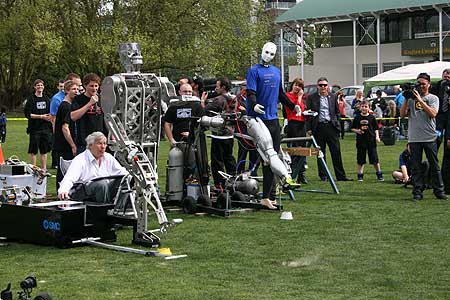Mehrtens matched by Massey's metallic man


Many think legendary former All Black Andrew Mehrtens has super-human powers when it comes to kicking a rugby ball. But a special robot created by Massey University Albany engineering students proved itself almost as good as its human rival in a man versus machine kick-off in Auckland yesterday.
Mr Mehrtens confronted three robots – one each from Massey’s Albany and Manawatu campuses, and another from Canterbury University – for the kick-off at Victoria Park. The fun event was part of the Rutherford Innovation showcase to highlight New Zealand’s innovative achievements in technology and industry during the Rugby World Cup.
Before a crowd of 100 or so onlookers and scores of international and local media, Mr Mehrtens tested his mettle against their metal in a series of conversion kicks over the goal posts using a Gilbert Rugby World Cup ball. The former Crusaders first five-eight player finally drew five-all with Massey’s Albany robot nicknamed ‘Robo Dan’ – a pneumatic-powered, muscular, metal leg attached to a human mannequin complete with swivelling robotic head.
Massey’s Manawatu robot,‘Woderwick’ cleared the goal posts beautifully during its warm-up but struggled with accuracy and distance later on, while Canterbury’s robot made up for missed attempts with its good drop kicking form. No groin injuries were reported.
Mr Mehrtens, an ambassador for NZ 2011, says the contest was “a tough ask” for the robots. “I’ve been doing this all my life. Along come some robots that were probably only born a couple of weeks ago.”
Associate Professor Johan Potgieter, mechatronics lecturer at Massey’s Albany campus, says he was delighted with the performance of the robot designed and created by his students. Creating a robot that could outdo an All Black legend took plenty of imagination and hard work. “It all starts with an idea, and how you innovate the idea. We look at nature, we look at some of the great rugby legends in this country and observe how they kick a ball. We realised it’s not just about power, it’s about timing too.”
He says the challenges of making the solid aluminium life-sized leg, which is joined to a mannequin, centred on getting the anatomy and movement accurate through kinematic design and computerised modelling.
The robotic leg is powered by pneumatic hoses, which are controlled by a Siemens XYZ programmable logic controller. It was made with the help of three visiting French engineering interns from Ensil, a state-owned advanced engineering school in Limoges, and local students. Robots like this one could be used in the testing of sports equipment such as rugby balls, he says.
NZ 2011 office director Leon Grice says the light-hearted contest has a serious purpose. “It showcases the innovation of New Zealand’s engineering students and universities which will be increasingly important for our country’s economic success. Making science fun with challenges like this helps promote engineering as a vocation and nurtures our future engineers.”
The robots will be on display during the first ever Robotics World Cup at The Cloud from October 11 to 13. Using the American-based Vex Robotics game model launched by Massey University in New Zealand in 2008, the event will involve 40 robots and university and high school teams from around New Zealand and Mexico designing, building and maintaining robots that compete in a game of speed, strategy, skill and adrenalin.